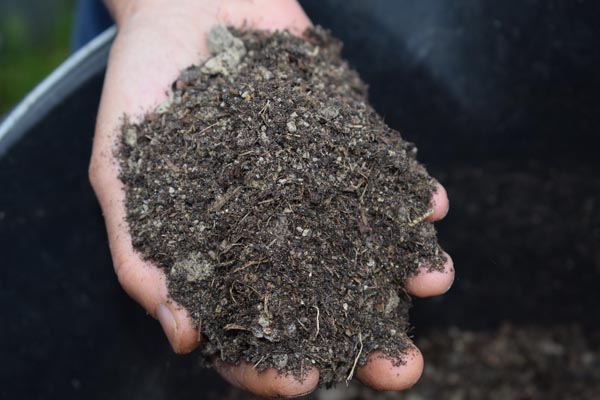Clay soil is a type of soil that includes fine particles of clay mixed into it. This type of soil is typically heavier than other kinds, drains rainwater slower in comparison to other soil, and takes a longer time to warm up in the summer months.
That being said, you can often find much more nutrients for your plants within this soil.
You’ll often find that clay soil is harder to work with than other soil types, but the rewards often overpower this disadvantage. Tilling is the action of turning the soil over and breaking it up to keep weeds and insects at bay. This also improves the aeration of your soil.

That being said, clay soil actually needs these insects for the nutrients in the soil. Earthworms are critical for allowing these benefits to reach the roots of your plants. Over-tilling your clay soil can actually be counterproductive and cause it to become too compressed.
For this reason, clay soil users may be reluctant to till their gardens. However, your soil does still need amending from time to time, so you cannot simply leave it and hope for the best.
Below we’ll be looking at six different alternatives to tilling that will enable you to improve the quality of your soil.
Six Alternatives to Tilling
#1 Organic Mulching
If you have a lawnmower that offers a mulching function, use it on your lawn. This simply cuts the grass, chews it up, and spits it back out onto your lawn rather than removing the clippings ready for the bin.
This mulch, as it breaks down and decomposes, will put its nutrients back into the soil for the growing grass to benefit from. What’s more is that those helpful earthworms like to snack on the mulch, so they’ll be drawn to it and therefore spread their fertilizer throughout the soil as they move.
Grass mulching is a popular method of improving clay soil as it requires very little effort and it’s free! As long as your mower has the function for it, you simply have to mow your lawn and let the grass do all the work.
#2 Dig and Drop Composting
Dig and drop composting is another highly used method of amending your clay soil without breaking the bank. It consists of digging a hole wherever you want to improve your soil, filling said hole with organic matter that you’ve had leftover from food scraps, and returning the soil back on top of this.
You want the hole to be deep enough to house all your waste without it spilling out of the top, but not too deep that all the nutrients are wasted thanks to the groundwater. We’d suggest not digging any deeper than 35 centimeters. Once your composting materials is in the hole, don’t compact them as they need enough oxygen around them to break up and compost effectively.
Dig and drop composting is easy, effective, and free! Plus, you’re repurposing your waste and making more of a conscious effort to get to a zero-waste household. Gone are the days of foul-smelling compost bins, simply bury the smell along with the scraps.
This is more effective than applying compost to the top layer of the soil as the nutrients will be able to reach more layers of the clay soil.
Having said that, of course, there is the question of how big your garden is. Digging one hole for your compost will allow it to penetrate the soil better, but if your garden is large, the nutrients might have a difficult time spreading out sideways. This might mean that not every area of soil will benefit from the nutrients.
The buried compost encourages bioactivity underneath your lawn which improves the overall quality of your clay soil. So, what are you waiting for? Get to the bin and find all that composting material!
#3 Liquid Aeration
Plants need oxygen around their roots to remain healthy and growing. This means that you’ll need to aerate the soil so that this oxygen can reach the roots. As we mentioned before, however, clay soil is heavier than other types of soil so it gets compact rather quickly in comparison.
Liquid aeration is simply mixing a solution with water and spraying it all over the soil in your garden. Ammonium Laureth Sulfate is often included in liquid aeration products, and you can also find this in soaps, shampoos, and other toiletries.
Both clay soil and Ammonium Laureth Sulfate are negatively ionically charged, meaning that when they come into contact with each other they will repel themselves away. When you spray the solution onto your soil, it will get to work breaking down the hard clumps and compressed soil so that roots have more room to grow.
Liquid aeration is not considered the most effective method of amending your clay soil, but it is helpful nonetheless. Some people live by this method, while others steer well clear. If you want to try this method, we’d suggest pairing it with another method to really amp up the effectiveness.
#4 Core Aeration
Alternatively, core aeration takes more effort from you as well as time, but also takes less time to see results than liquid aeration. Using this method calls for you to remove plugs of the soil of your garden. You can remove this and fill the holes back up with organic matter such as mulch and composting products. This will protect the roots from insects and pests, but will allow more oxygen to reach them.
Completing this task regularly will allow your soil to continue to house your plants efficiently and prevent their growth from being stunted. As we mentioned earlier, clay soil is much heavier and retains more water than other types of soil. This calls for more aeration so that the water can be drained often so that the soil doesn’t get too compact around the roots of your plants.
Moreover, adding organic matter to your soil regularly will draw the earthworms towards it as they like to eat it, and therefore they’ll fertilize more of the soil as they’re traveling through it. This will benefit your plants greatly and offer them more nutrients to thrive.
Core aeration works very well with top dressing, which is another good way to improve the quality of your clay soil. We’ll be looking at this below. Pairing these two methods together will improve your soil greatly without breaking the bank.
#5 Top Dressing
As promised, now let’s discuss top dressing as a method of amending your clay soil. We’ve touched on this before, but it is the act of spreading organic matter over the top of your soil. This is similar to organic mulching, but instead of grass mulch, you spread composting materials over the top of the soil.
Organic matter is described as anything that has come from a recently living organism. The most common example that you’ll have access to is food waste that has the potential to break down, such as fruit and vegetable peelings and scraps.
While top dressing refers to simply spreading this matter on top of the soil, many people have seen less than impressive results with this method. This is because the nutrients from the breaking down organic matter is only reaching the top layer of soil and not the lower layers.
This is why we suggest using this method alongside core aeration techniques. This allows the beneficial components to reach lower into the soil and improve your overall garden more effectively. Alternatively, you could simply use the method of dig and drop composting.
One benefit from top dressing and core aeration opposed to dig and drop composting is that the former method allows the nutrients to spread more evenly throughout the soil than the latter option. This is because you’re planting the organic matter in smaller holes all over the soil, rather than just one big hole in one area.
#6 Deep Soil Integration
Next up is deep soil integration, which is similar to core aeration, just amped up to the next level. For this method, you’ll need to drill into the soil before planting the organic matter in each of these holes.
Drilling into your soil will also allow better drainage for the excess water that tends to get trapped in clay soil, which is another added benefit. Moreover, you’ll be able to drill deeper into the soil than you’d be able to reach by removing plugs from the garden.
Reaching more layers of your soil with the nutrients from your organic matter explains the benefits itself, so we don’t even have to tell you. What we will say, though, is that many gardeners who use clay soil have seen excellent benefits from this method.
That being said, this is one of the more demanding methods that will take more of your time and effort. It’s really up to you how much effort you want to put into your garden and whether you want to spend the extra time to see the extra benefits.
Moreover, you’ll need a drill for this method with a considerably large drill bit. If you don’t have one of these, you may need to spend extra money on purchasing one, however, we’re sure that it’ll come in handy sooner or later!
Another thing to consider is that the quick movements of the drilling could overwork the soil, much like tilling could. You should be careful if you opt for this method to ensure that you’re not drilling the hole too close together to prevent overdoing it.
Using Different Techniques Together
We’ve touched upon this earlier in the article, but we thought we should give you a quick example of how to mix and match these different methods of how to amend clay soil without tilling. Of course, the more methods you can incorporate into a routine, the better.
Here’s an example of how to use each of the methods that we’ve talked about above to improve your soil as much as possible.
Firstly, core aerate the soil and plug the bottom of the holes with organic matter.
In the spaces without holes from the first step, deep soil integrate and drill further into the soil.
Mow the lawn with your mulch setting on. Don’t disturb the placement of this too much.
Apply a top dressing of any organic matter that you have left. Take a rake and move both the mulch and top dressing around so that all of the holes are full and your garden is even.
Finally, take a liquid aeration solution and sprinkle this all over the soil. Doing this last will allow the solution to penetrate inside the holes and reach deeper layers.
We suggest dig and drop composting whenever your inside compost bin gets full. Just remember to leave enough for the other methods described in our example routine above!
Conclusion
There we have it - our advice on how to amend clay soil without tilling. The six alternative methods are much more gentle than tilling, and often give you and your soil as effective results. The more of these methods that you can incorporate into your gardening routine, the quicker you’ll be able to see amazing results.
We’ve included methods of varying effort and time levels, but bear in mind that time and effort are relevant to how drastic the benefits are. Often you get out what you put in with your garden, so don’t only liquid aerate and expect to see the greatest results.
While deep soil integration is most likely the most effective method that we’ve detailed, remember that it could also give you undesirable results if you overwork the soil too much. For this reason, we’d suggest listening to the clay soil and mixing and matching the methods accordingly.

